Ten Pictures That Tell Us Human Stories of The Forgotten Holocaust
30 July 2015
“The world has learned nothing from the Holocaust” - says Sinto Holocaust Survivor Zoni Weisz, whose entire family was murdered by the Nazis. He often calls the Roma Holocaust a forgotten Holocaust because most people have never heard about it. This is why we’ve launched an online campaign related to the day of commemoration of the Roma Holocaust. We used original photos provided by the United States Holocaust Memorial Museum to illustrate the stories and less known facts.
Please visit our Facebook and Twitter pages.
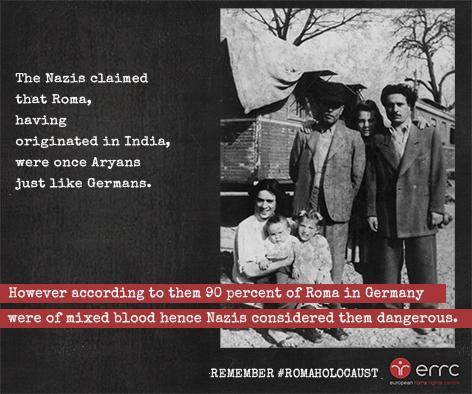
In 1936, Dr. Robert Ritter became the director of the Center for Research on Racial Hygiene and Demographic Biology in the Ministry of Health and began a racial study of Roma. He declared that Roma, having originated in India, were once Aryan but had been corrupted by mingling with other peoples during their long migration. Ritter estimated that some 90 percent of all Roma in Germany were of mixed blood and were consequently carriers of "degenerate" blood and criminal characteristics. Because they allegedly constituted a danger, Ritter recommended they be forcibly sterilized. The remaining pure-blooded Roma, Ritter argued, were to be placed on a reservation and studied further. In practice, little distinction was made between Ritter's so-called pure-blooded and mixed-blooded Roma. They all became subject to the Nazi policy of persecution and, later, mass murder.
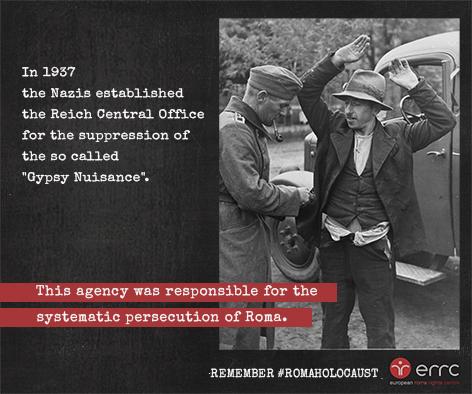
Persecution of Roma in Germany, and indeed in all of Europe, preceded the Nazi takeover of power in 1933, but it was in 1937 that police in Germany began more rigorous enforcement of pre-Nazi legislation against those who followed a lifestyle labeled "Gypsy." That year the Nazis, after constructing a register of almost all Roma then living in Germany, established the Reich Central Office for the Suppression of the "Gypsy Nuisance".
Romani individuals were arrested as “asocials” or habitual criminals” or forced into municipal camps. These camps later evolved into forced-labor camps. From these, many were sent to concentration camps. Nearly every concentration camp in Germany had Romani prisoners.
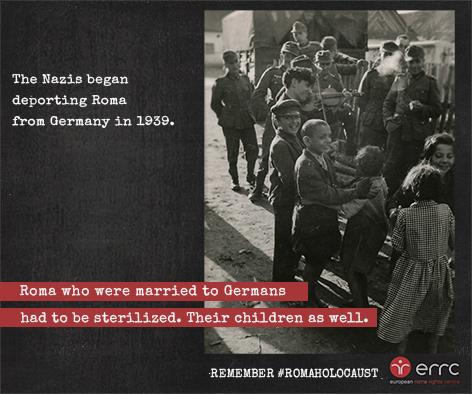
Altogether an estimated 300,000 to 400,000 people were sterilized under the “Sterilization Law”. The law did not target so-called racial groups, such as Jews and Roma. A diagnosis of "feeblemindedness" provided the grounds in the majority of cases but many Roma were sterilized as deviant "asocials," as were some homosexuals. Only the Roman Catholic Church, for doctrinal reasons, opposed the sterilization program consistently; most German Protestant churches accepted and often cooperated with the policy.
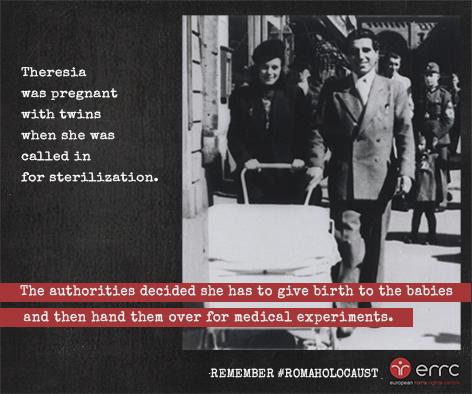
In 1941 several members of Theresia Reinhardt's family were brought to Gestapo headquarters where they were forced to sign sterilization authorization forms. They were threatened with deportation if they refused. Before Theresia's sterilization was scheduled she made a conscious decision with her boyfriend, Gabriel, to get pregnant. By the time she was called in for the procedure, she was three months pregnant with twins. When this was discovered by the racial hygienists, she and her family were detained and word was sent to Berlin to determine what should be done. The response was that Theresia should be allowed to continue the pregnancy on condition that the babies would be turned over, upon their birth, to the clinic at the University of Wuerzburg. There, Dr. Werner Heyde, professor of neurology and psychiatry, and a key member of the Nazi euthanasia program, was conducting research on twins. Only one of the children has survived the experiments.
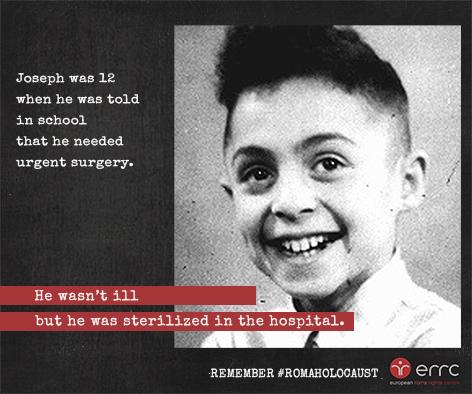
Joseph Muscha Muller was born in Bitterfeld, Germany but he never knew his parents. At school, he was often made the scapegoat for pranks in the classroom and beaten for "misbehaving." He was also taunted with insults like "bastard" and "mulatto" by classmates who were members of the Hitler Youth movement. At age 12, he was taken from his classroom by two strangers who said he had "appendicitis" and needed immediate surgery. He was beaten, then sterilized. After surgery, he was to be deported to a concentration camp, but his foster father had intervened. He survived the remainder of the war hiding for 5 months in a garden shed.
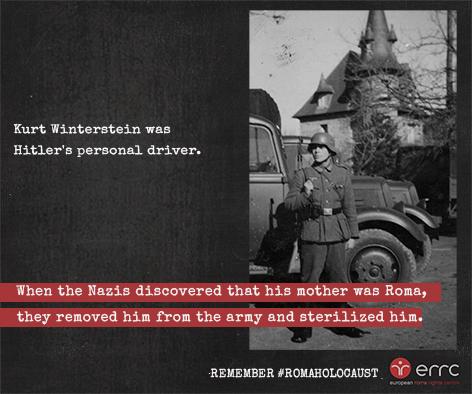
Kurt Winterstein was one of Hitler's personal drivers. When the Nazis found out that his mother was Roma they took him out of the army and sterilized him.
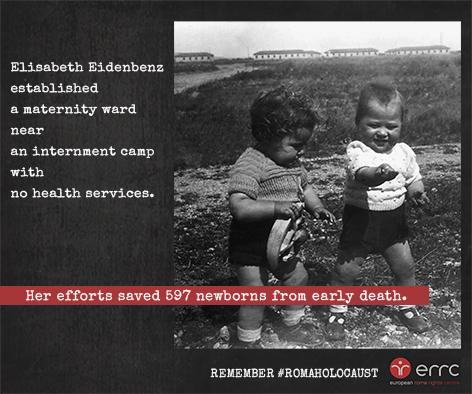
Elisabeth Eidenbenz established a maternity ward in an abandoned castle near an internment camp for Spanish refugees in France. She was only 24 at the time. After 1940 the Vichy regime started using the camp for internment of Jewish and Roma people. Elisabeth has made an arrangement with camp officials, that allowed pregnant women close to term to stay at the ward for better nourishment and medical care before, during, and after delivery. Her efforts saved 597 newborns from early death, until the Germans closed the ward in April 1944.
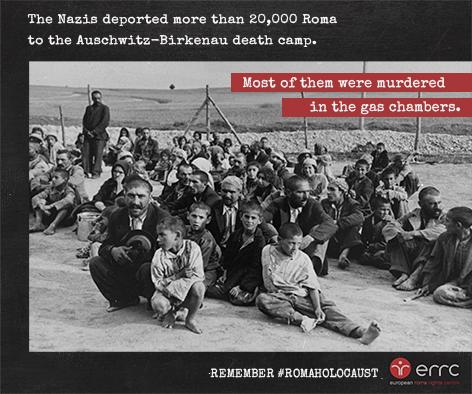
The legal interpretations of the 1935 Nuremberg Laws were later adapted to include Roma. The Nazis termed Roma "work-shy" and "asocial"—in the Nazi framework, unproductive and socially unfit. The Nazis also deported more than 20,000 Roma to the Auschwitz-Birkenau camp, where most of them were murdered in the gas chambers.
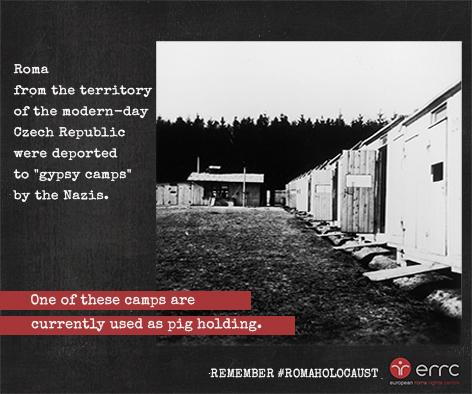
During the Nazi era Roma in the Protectorate of Bohemia and Moravia were deported to the “Gypsy camps” at Lety and Hodonin. Over 1,300 Romanies were interned in Lety. 327 perished in the camp, while 500 were sent to Auschwitz. Circumstances were terrible at Lety, the Roma children were beaten and starved. Romani women were forced to wash naked in a pond near the camp while the warders sexually abused them. A 10-year-old girl reported that she was forced to stay with corpses for three days without food in a wagon after she was beaten. Most of the perpetrators were not Germans, but Czech natives.
Today several NGOs protest against the use of the Lety camp as a pig holding.
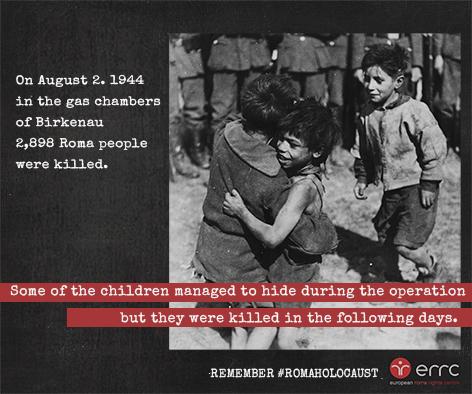
In May 1944, the camp leadership decided to murder the inhabitants of the Gypsy compound. The SS guards surrounded and sealed off the compound. When ordered to come out, the Roma refused, having been warned and having armed themselves with iron pipes, shovels, and other tools used for labor.
The SS leaders chose not to confront the Roma directly and withdrew. After transferring as many as 3,000 Roma capable of work to Auschwitz and other concentration camps in Germany in the late spring and early summer of 1944, the SS moved against the remaining 2,898 inmates on August 2. Most of the victims were ill, elderly men, women, and children. The camp staff killed virtually all in the gas chambers of Birkenau. A handful of children who had hidden during the operation were captured and killed in the following days.
On April 15, 2015 the European Parliament recognized 2nd of August as the European Roma Holocaust Memorial Day.




